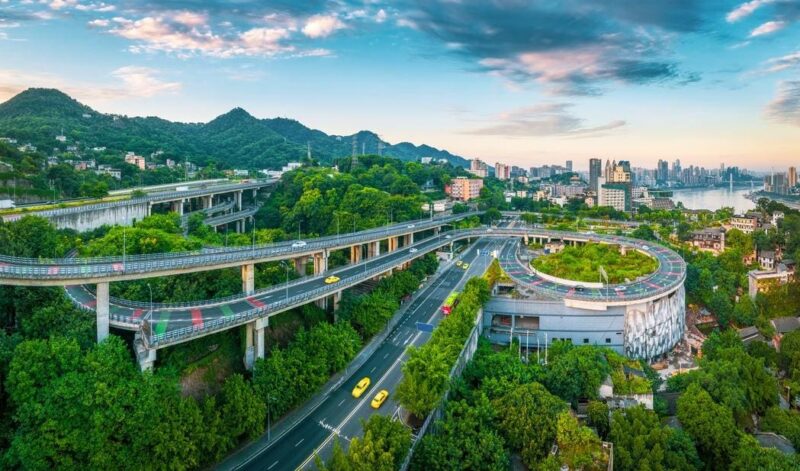More than two-thirds of globally threatened species are directly impacted by recent city growth
Cities like Chongqing are undergoing hillside urban expansion at an unprecedented rate
getty
In 1950, 40% of the world’s human population lived in rural areas. Today, that figure has been cut in half according to the UN, as 80% of people on the planet now live in towns and cities. Our urban areas continue to expand to accommodate our growing population. The same UN report shows that since 1975, the amount of land classified as “built-up” and occupied by humans grew almost twice as fast as the global population. As a result, the built-up-area-per-person rose from 43 to 63 m2.
In a new study published in Nature Cities, researchers have found that this rapid urbanization, combined with competition from agriculture for flat land, is driving city growth into hillsides, mountains, and other upland areas. And the consequences for the planet’s biodiversity are dire.
Mapping the problem
Using 30-m-resolution spatial landform maps that cover the globe, the team showed that between 2000 and 2020, hillside urban areas grew by 11.65 million hectares (Mha) globally; an area larger than the country of Iceland (10.1 Mha).*
In terms of geographical extent, Asia saw the greatest increase of hillside urbanization – 5.09 Mha in the twenty-year study period, with China representing the majority (3 Mha) of that total. This was followed by North America (2.68 Mha) and Europe (1.95 Mha). In terms of the highest rate of hillside development relative to total urban growth, South America took the top spot, at nearly 25%. Oceania and North America followed closely behind (20.52% and 20.35%, respectively).
Hillside areas are where most residual terrestrial biodiversity resides. Habitats such as forests and wetlands are refuges for countless species of plants and animals. As cites begin to encroach into them, such habitats are lost or fragmented, isolating species, and exacerbating soil erosion.
By utilizing land-use maps, this study could demonstrate the direct consequences of hillside urbanization on habitat loss and fragmentation at global, continental, national, and local scales. They found that globally, it accounted for an estimated 6.73 Mha of habitat loss between 2000 and 2020 (an area about the same size as Lithuania). And that hillside urbanization alone was “responsible for 31.11% of forest loss, 3.50% of grassland loss, 26.79% of shrubland loss, 3.26% of wetland loss and 10.80% of unused lands.”
Habitats are losing out to urban expansion
getty
Hotspots for nature
They also looked at the world’s biodiversity hotspots – regions that are particularly rich in unique biological resources, and which are under severe threat. These regions, which occupy less than 2.4% of Earth’s land surface, are home to more than half of the world’s plant species and at least 42% of all terrestrial vertebrate species. And yet, more than a third of all hillside urban expansion is happening in these areas. Most affected was the Mediterranean basin, which experienced a habitat loss rate of ~65%.
With such significant habitat loss and fragmentation, the authors wanted to understand the risk that this poses to species in these hotspots. They focused on vertebrates – birds, mammals, reptiles and amphibians – classified as near-threatened, vulnerable, endangered or critically endangered.
They found that since 2000, hillside urban expansion has directly affected the distribution of close to 6700 threatened species (70.14%) worldwide. Among the four groups they looked at, birds (81.75%) and mammals (81.18%) were the most significantly affected.
Some cities use greenbelts to protect habitats for wildlife, but hillside urban expansion can threaten them (Wellington, New Zealand)
getty
What the future holds
The authors warn that without urgent action on hillside urban expansion, the situation is only going to get worse. They looked at five Shared Socioeconomic Pathways (SSPs) – established scenarios or pathways that the world may take – to understand the potential future impact on biodiversity. They predict that that by 2050, 53 countries will likely fail to meet even weak biodiversity conservation targets due to continued hillside development. Ten biodiversity hotspots are forecasted to miss the mark by 2030, with this figure rising to 12 by 2050.
They write, “Long-term solutions hinge on reconciling economic growth with ecological resilience.” They suggest reforms such as prioritizing irreplaceable habitats (e.g. wetlands, old-growth forests) in zoning discussions, and enforcing ‘no-go’ thresholds for urban sprawl. They point to strategies such as ‘land sharing’ and ‘land sparing’, as a way to maintain a balance between food production and biodiversity conservation; to adopting compact city design coupled with greenbelts as a means to meet housing needs while keeping habitats intact; and to reducing the footprint of transportation infrastructure to protect sensitive habitats. They offer their global maps of hillside urban expansion risks as “a blueprint for prioritizing actions.”
The study underscores an uncomfortable reality: as flat land becomes scarce, cities face a choice between building upward within existing boundaries or expanding outward, potentially into ecologically sensitive terrain. The planning decisions made in the coming decades will shape not only the future of urban development but also the survival prospects for thousands of species that call Earth’s hillsides home.
* If you prefer your area metrics in the form of sports fields, 11.65 Mha is equivalent to just over 14.5 million soccer pitches.









